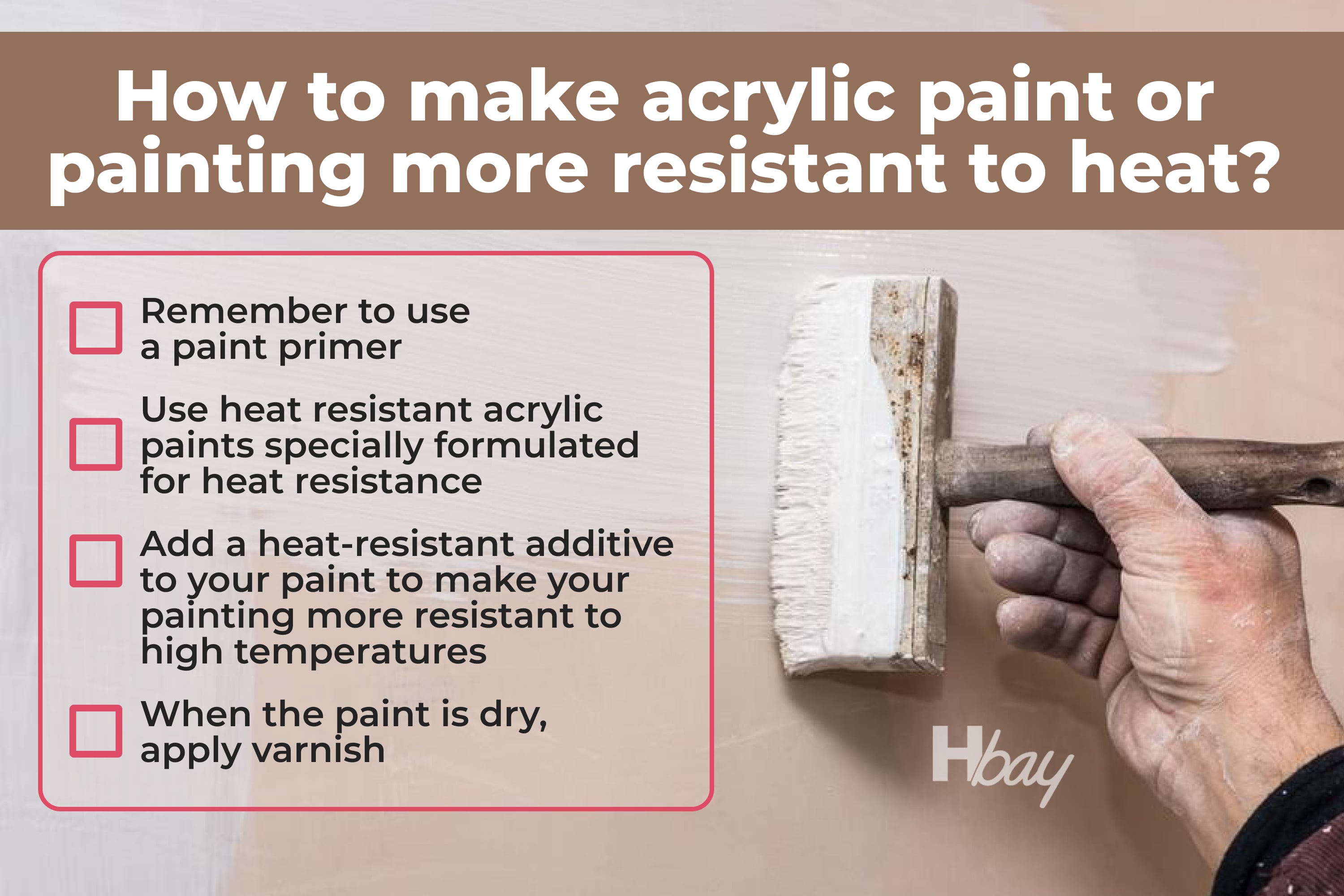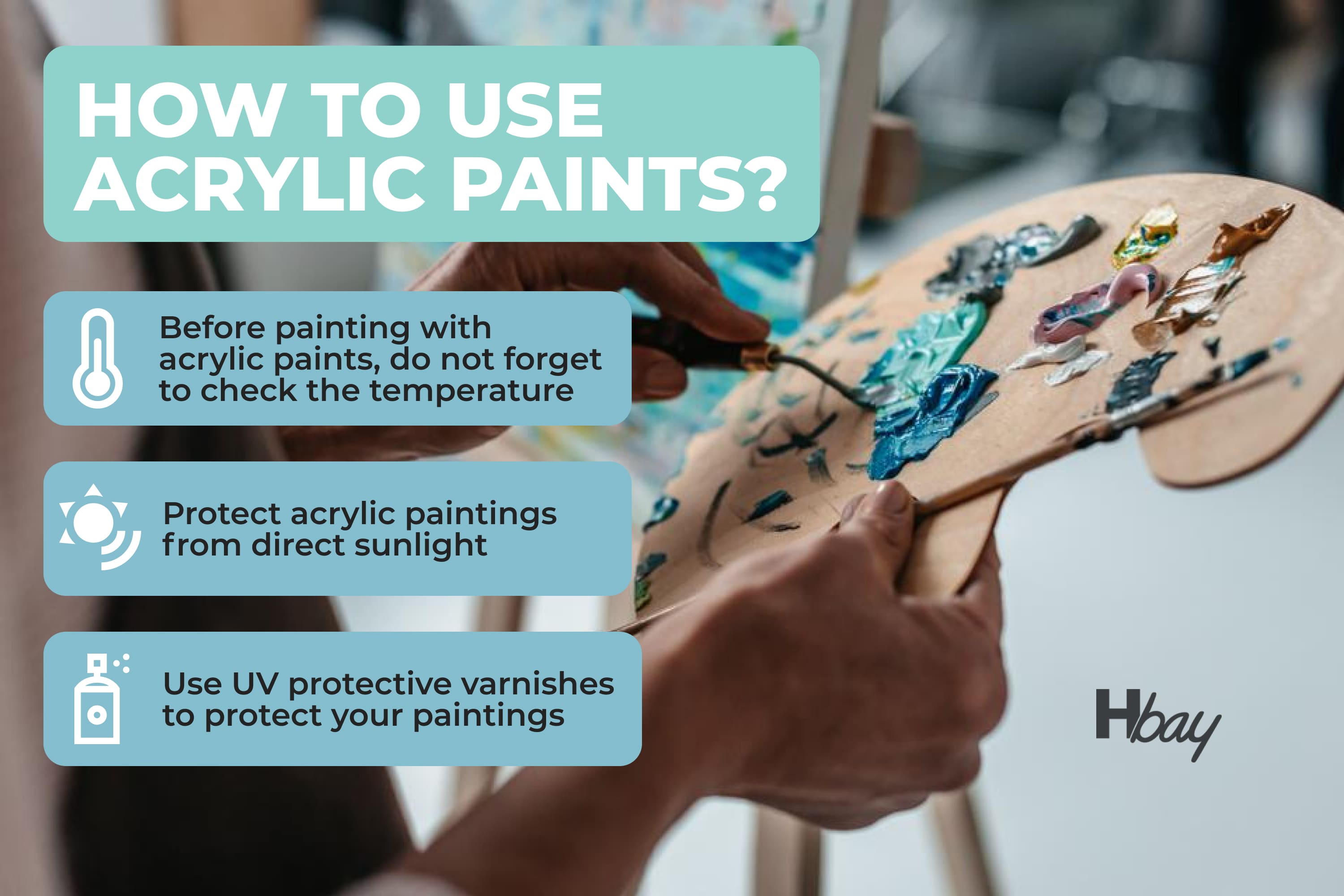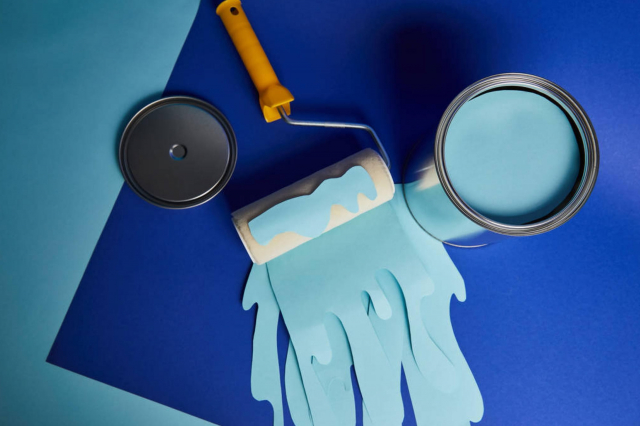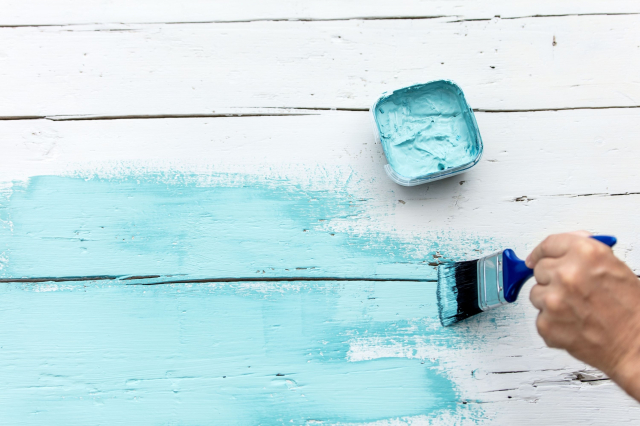Acrylic Paint Heat Tolerance. Deep Guide
Is acrylic paint heat-resistant? Let’s figure this out
No matter whether you are an enthusiast artist or you just want to refresh the interior or exterior of your home, using acrylic paint is one of the best options. This paint is versatile, it comes in a wide range of colors, and besides, it can be used on many surfaces!
However, those who are going to use acrylics for the first time often face the same issue: what temperature can acrylic paint withstand? This question becomes even more crucially important if you are going to paint any outdoor items or you are going to make a painting that you’d like to keep as long as possible.
So today we will explain how acrylic paint may react to heat and different temperatures. In particular, you will learn whether acrylic paint is heat resistant. Also, you will learn how it will behave in different temperatures, both hot and cold. As a result, you will know how acrylic painting will feel when it’s cold or hot in a room where it is kept.
In addition, you will learn a few other useful facts about acrylics and the way this paint reacts to different temperatures. As a result, you will be aware of the paint’s specifics and will manage to use it successfully in different conditions.
Is Acrylic Paint Heat Resistant?
Let’s start with acrylic paint heat resistance at once. People often wonder whether this paint has any heat-resisting powers. The answer is that it depends on what temperature you are trying to use the paint at. See, acrylic paint is actually a plastic that is made from polymer emulsion. So by its nature, this paint is not heat resistant at high temperatures. However, it can withstand low temperatures pretty well without any problems.

But what is the acrylic paint temperature range that it can cope with, you may be wondering now. The temperature range that acrylic paint can withstand more or less easily is between 60 F and 75 F (16C – 26C). This is the stable room temperature for storing paintings made with acrylic paints.
However, you need to keep one thing in mind when it comes to using acrylic paint indoors be it a painting on the wall or a surface/object coated with this kind of paint. See, acrylic paint is water-based, which means that it needs more or less constant temperatures in a room to be able to keep itself stable.

housekeepingbay.com
Of course, some minor temperature fluctuations (like a couple of degrees higher or lower) will not harm your painting or other surfaces. But you should not let your acrylic painting be exposed to serious temperature changes!
This is why home painters are often confused about whether their acrylic paintings will start to melt down if exposed to the sunlight directly. But there is no need to worry! Your acrylic painting can’t melt until the temperature in a room reaches 320 F (or 160 C.
It can, however, become softer at high temperatures but it will not melt or start running down the canvas! Acrylic paints are quite a heat resistant to a certain point, so typically, they can do pretty well even in a warm room.
However, if it’s way too hot around, this kind of paint may quickly dry out, resulting in a rough and uneven finish. Also, brush marks may remain on the paint surface, and often, there can be tiny cracks on the paint coating as well.
As a result, the painting may not look attractive, resembling a rough scorched surface with a harsh finish instead of a smooth finish.

kosmos111 via VistaCreate
Table of Contents
How Do I Make Acrylic Paint Heat Resistant?
We want to make it clear at once that you will hardly be able to make your acrylic paint completely heat-resistant so that it can survive even the highest temperatures! However, with the help of a few simple steps, you can help this paint to become stronger and be able to withstand heat better.

housekeepingbay.com
The following steps will help you make your acrylic paint or painting more resistant to heat:
- Remember to use a paint primer to create proper protection between the paint and the surface you are painting on
- Use heat-resistant acrylic paints that are specially formulated to be heat resistant
- Add a heat-resistant additive to your paint to make your painting more resistant to high temperatures
- Once your paint is dry, apply a varnish to protect it from heat
With these simple steps, you will be able to make your acrylic painting more heat-resistant, as well as help your paint last longer even if it’s exposed to heat or direct sunlight, for example.
Now you know acrylic paints won’t melt and they are also a bit resistant to heat. Also, you have learned a few life hacks that will allow you to add strength to your acrylic painting and make it heat-resistant. So now let’s figure out how this kind of paint can react to the opposite conditions, meaning how acrylic paint will behave under the conditions of cold.

AllaSerebrina via VistaCreate
How Can Low Temperatures Affect Acrylic Paint?
Speaking of low temperatures, you should still keep in mind the fact that acrylic paint is water-based. It means that, if you paint with acrylics or you leave the acrylic painting to dry in a cold room, the water-based acrylic paint will not be able to dry as quickly as it should be.
This is due to the water vapors not being able to evaporate quickly enough. As a result, the drying time of your canvas will be delayed. So if you are painting in a cold room or studio, you must be patient to let your artwork dry completely since it can take days!

Also, you should take into consideration that cold weather and low temperatures may result in microscopic ice crystals in the coating of acrylic paint. As a result, you may end up with a brittle paint finish!
Low temperatures can also cause the paint to become thicker. This is why it takes so much time for acrylics to get dry when it’s cold around.
Finally, if you keep your acrylic painting or anything painted with it in a cold room for too long, the paint may not properly dry because of its thickness. So even if you have to paint with acrylics in cold surroundings, try to make it as warm as possible, but still, keep the temperature within the allowed limits of warmth!

AllaSerebrina via VistaCreate
What Effect Can Humidity Have On Acrylic Paintings?
If you want to get an ideally smooth and flawless acrylic finish on your canvas or on any other surface, you should keep not only the temperature but also humidity under control! Both temperature and humidity extreme fluctuations are the worst enemies of your acrylic painting’s perfect finish.

housekeepingbay.com
When there is high humidity in the air, the layers of acrylic paint remain wet and cannot properly dry out. This is why we would like to share a few handy tips and recommendations with you that can help anyone to keep your acrylic projects properly protected:
- Keep your acrylics at the constant temperature (16-26C) and in a place with low humidity
- Before painting with acrylics, remember to check the forecast
- Prevent your acrylic paintings from direct sunlight exposure
- Use UV-protecting varnishes to protect the paintings
So the ideal surrounding for acrylic paintings to be stored is to keep them in the 60 F to 75 F temperature range. In this case, your paintings will not be damaged and the paint will not dry out, crack, or fade.
Also, remember to avoid storing acrylic paintings in below or above the recommended temperature range and make sure the humidity level is safe for the paint.

AntonMatyukha via VistaCreate
How Can You Make Your Paintings Last Longer?
When you make a painting, you definitely want it to last as long as possible! But how to do that if you are painting with acrylics? Well, it’s pretty easy in fact. Make your paintings last longer by following simple tips and life hacks that experienced acrylic painters use:
- Make sure you are using high-quality paint
- Follow the manufacturer’s instructions carefully when using and storing your paints
- Test the paint on a small area before applying it to the entire surface or canvas
- When storing your paintings, keep them out of direct sunlight
- Keep your paintings away from high temperatures (e.g. heaters, fireplaces, way too warm rooms, etc.)
- Remember that any paint’s heat resistance is relative!
Well, now you guys know more about acrylic paint and the way it reacts to heat.
You learned that this type of paint can hardly be called heat-resistant although it does feature some kind of heat resistance. Nevertheless, as we have figured out today, acrylics should still be used and kept at a certain temperature range to ensure a proper paint finish condition.
Also, you learned how you can help your acrylic paint and painted surfaces become more resistant to high temperatures and what steps should be taken in order to help your acrylic masterpieces last longer.

artlu via VistaCreate
Ever wished paint sampling was as easy as sticking a sticker? Guess what? Now it is! Discover Samplize's unique Peel & Stick samples. Get started now and say goodbye to the old messy way!
Get paint samples




Frequently Asked Questions
⭐Is enamel paint heat-resistant?
Most enamel paints are oil-based, giving you a solid finish that is heat-resistant.
⭐Does acrylic melt in heat?
Unless the temperature is very high, this paint will not melt.
⭐Is there heat resistant latex paint?
No, latex paints are typically not heat-resistant at all.
4 thoughts on “Acrylic Paint Heat Tolerance. Deep Guide”
Leave a Reply








If acrylic paint is not heat-resistant, can you use it outside? Is it possible it get damaged under the direct sunlight?
Well, acrylic paint can be used outside for sure since it’s one of the most popular paints to sue on garden furniture. It can be used on walls, fences, and other surfaces! However, you should really keep in mind that it is not weatherproof and will not withstand harsh weather conditions! And yes, if constantly exposed to sun, it can fade and start cracking.
Hello! Thank you for such a useful article! Could you please tell me whether tempera paint is heat resistant to a certain point? Thank you!
Hello! Speaking of tempera paint, it is not as durable as acrylic paint, and it is not as heat resistant. Tempera is not as flexible as acrylic paint, so it is more likely to crack when exposed to high temperatures. However, you can still make tempera paint heat-resistant by adding varnish or using a heat-resistant primer.